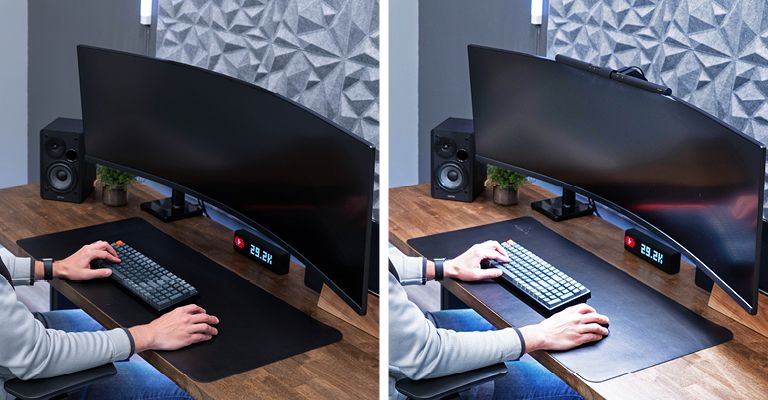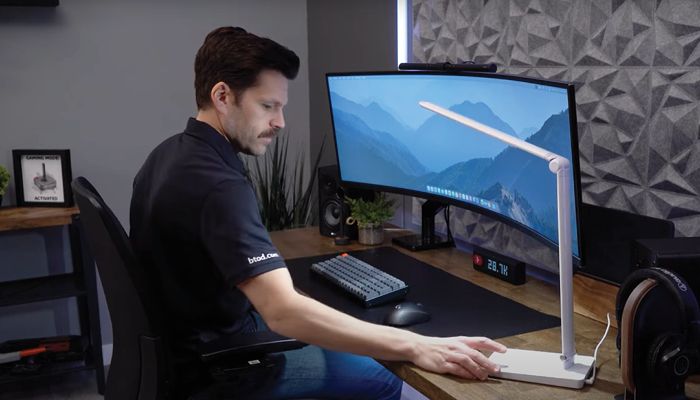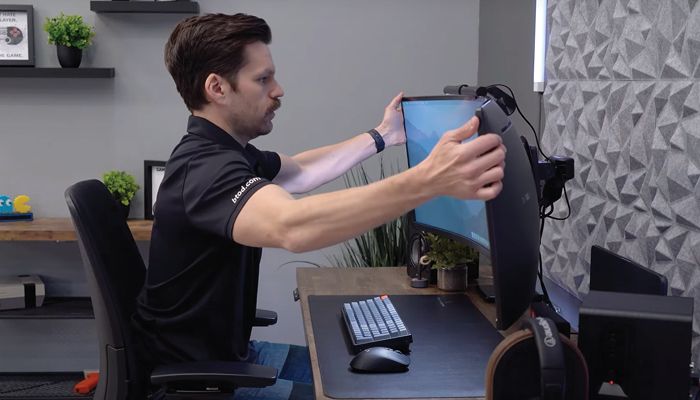If you are anything like me and you spend 10-12 hours a day at your desk, there is a good chance that you are also dealing with discomfort. That is why we put together simple tips that will help make sure that you are always comfortable at your desk.
Full Disclaimer: We are an office furniture dealer and sell some of the products we review. To learn more about the products we sell, our review process and why you can trust us, please visit: Why we’re different. Who is BTOD.com and The Breakroom Blog?
5 Tips For Desk Comfort Links
- Install Good Lighting
- Find the Right Office Chair
- Find The Right Desk Height (Standing Desk)
- Add an Ergonomic Footrest
- Figure out the Right Monitor Position
1. Install Good Lighting
A lot of us have bought into the myth that low lighting will be hard on your eyes, especially over time. However, that is just a myth. While it is true that poor lighting can cause headaches, discomfort, and a lack of efficiency. Good lighting that will keep you comfortable and productive throughout the day begins with the right overhead lighting and incorporating as much natural light as possible.
From there task lighting, which really puts the focus directly on your workspace, should be the next priority. Typical task lights that we are used to seeing tend to have shortcomings when it comes to reach. A better alternative is monitor light bars that sit directly on top of your monitor. They are out of the way, they don’t take up room on your desk, and they focus the light right where you want it.
2. Find the Right Chair
You want to find a chair that is both supportive and comfortable. As a company dedicated to office chairs, it should come as no surprise that we are prioritizing finding the right chair, but it truly is a foundational part of your office setup. Understanding ergonomics can be difficult, especially because many people assume that if they are comfortable, they are also benefiting from the proper ergonomics, but that isn’t always the case. Fit and support are also essential. Without these, you will begin to develop habits that will cause problems down the road.
3. Find the Right Desk Height
Finding the right desk height can be a bit confusing. The standard sitting desk will be 29” to 30” tall, which is great for those who are 6’ to 6′ 2” tall, but might not be for the rest of the population. Ideally, you want your arms to be able to rest comfortably at your side and on the armrests of your chair without any awkward positioning that will put strain on your wrists while you are typing or using your mouse.
If you don’t find a good fit with a standard desk, you may want to consider a standing desk. While the name implies that they are for standing only, they actually offer a full range of sit to stand heights that often start at 28”. Some models will even drop down to 22”. For a solution that won’t require you to replace your existing sitting desk, take a look at our next tip.
4. Add a Footrest
In our office, there is only one person who doesn’t use a footrest and we have a team that ranges from 5’2” to 6’2”, which says something about the functionality of this accessory. Shorter users can utilize the footrest to bring themselves closer to a desk that is too tall for them. At the same time, even if your desk is the perfect height, it is nice to be able to perch your feet and have a little extra movement throughout the course of the day.
5. Figure out the Right Monitor Position
The rule of thumb is to have a monitor that is at eye level or below and about arm’s length from where you are sitting. Of course, this varies. You might be more comfortable being further away from larger monitors. If you’ve been working from a single monitor, there is a good chance that your productivity would benefit from a dual screen or extra wide setup.
For those with a multiple monitor situation, there is even more importance put on how the screens are oriented. Some people like to put both monitors in the landscape. Others prefer to have one in landscape and the other in portrait where the extra height definitely helps with efficiency in programs like Excel. The key is to make sure the main monitor is positioned directly in front of you so your focus is in the right place and the positioning isn’t creating any additional neck strain.











